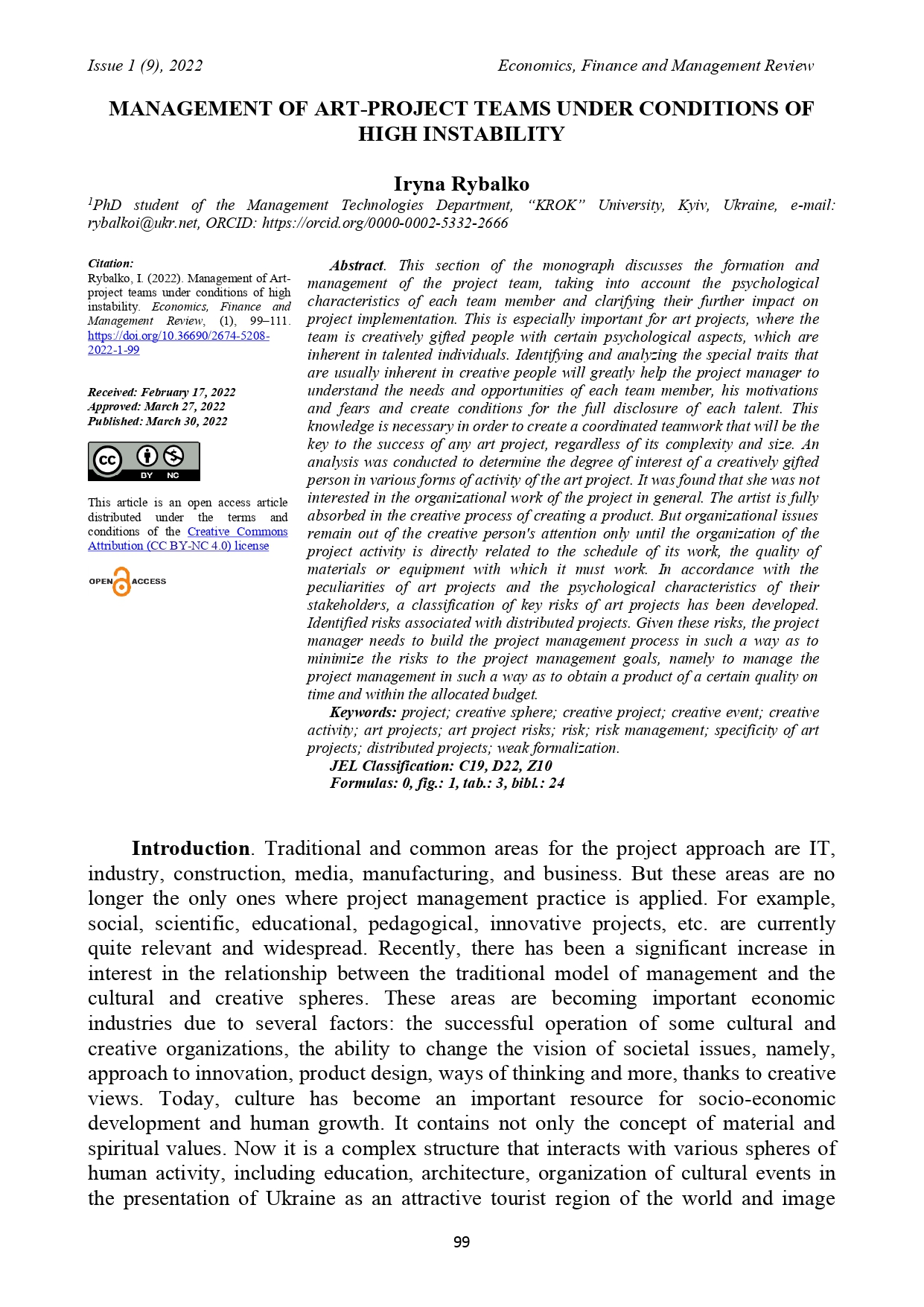Management of Art-project teams under conditions of high instability
DOI:
https://doi.org/10.36690/2674-5208-2022-1-99Keywords:
project, creative sphere, creative project, creative event, creative activity, art projects, art project risks, risk, risk management, specificity of art projects, distributed projects, weak formalizationAbstract
This section of the monograph discusses the formation and management of the project team, taking into account the psychological characteristics of each team member and clarifying their further impact on project implementation. This is especially important for art projects, where the team is creatively gifted people with certain psychological aspects, which are inherent in talented individuals. Identifying and analyzing the special traits that are usually inherent in creative people will greatly help the project manager to understand the needs and opportunities of each team member, his motivations and fears and create conditions for the full disclosure of each talent. This knowledge is necessary in order to create a coordinated teamwork that will be the key to the success of any art project, regardless of its complexity and size.
An analysis was conducted to determine the degree of interest of a creatively gifted person in various forms of activity of the art project. It was found that she was not interested in the organizational work of the project in general. The artist is fully absorbed in the creative process of creating a product. But organizational issues remain out of the creative person's attention only until the organization of the project activity is directly related to the schedule of its work, the quality of materials or equipment with which it must work. In accordance with the peculiarities of art projects and the psychological characteristics of their stakeholders, a classification of key risks of art projects has been developed. Identified risks associated with distributed projects. Given these risks, the project manager needs to build the project management process in such a way as to minimize the risks to the project management goals, namely to manage the project management in such a way as to obtain a product of a certain quality on time and within the allocated budget.
Downloads
References
Rybalko I.V., Danchenko O.B., Melenchuk V.M., Berezensky R.V. Project approach in the creative sphere. Bulletin of the National Technical University "KhPI". Series: Strategic Management, Portfolio Management, Programs and Projects. Bulletin of the National Technical University "KhPI". Series: Strategic management, portfolio, program and project management. Kharkiv: NTU "KhPI", 2020. № 1. P. 24-30.
Bushuyev, S.D., Morozov, V.V. Dynamic leadership in project management: Monograph. Ukrainian Project Management Association. 2nd type. K .: UAUP, 2000. 312 p.
Bushuev, S.D., Bushueva N.S., Babayev I.A. [etc.] Creative technologies for project and program management. Kyiv: Summit Book, 2010. 768 p.
Danchenko O.B. Method of managing the value of an art project / O.B. Danchenko, D.V. Bass // Project Management: Status and Prospects. Proceedings of the XIV International Scientific and Practical Conference. - Mykolaiv: Publisher Torubara VV, 2018. - P. 33-34.
Bass D.V. Art projects, their features and definitions. Bulletin of Cherkasy State Technological University. Series: Technical Sciences. № 3, 2016. pp. 57-62.
Project Management Knowledge Code Guide (PMBOK® Guide). - Sixth edition. Project Management Institute, Inc. 2017 - 695 p.
ISO / TR 10006: 1997 €. Quality Management - Guidelines to quality in project management - p. 24
IPMA Competence Baseline. Version 2.0. IPMA Editorial Committee. Bremen: Eigenverlag, 1999. - p. 23.
Fundamentals of individual competencies for Project, Program and Portfolio Management (National Competence Baseline, NCB Version 4.0) Volume 3. Project portfolio management Bushuev S.D., Bushuev D.A.; Edited by Bushuev S.D. K.: "Summit Book", 2017. 168 p.
Dictionary of the Ukrainian language. In 11 volumes. Kyiv: Naukova Dumka, 1970-1980.
Creativity. Ukrainian small encyclopedia: 16 books. : in 8 volumes / prof. E. Onatsky. - Published by the UAOC Administration in Argentina. - Buenos Aires, 1966. - Vol. 8, vol. XV: Letters V - Uts. - P. 1884-1885. - 1000 copies.
On professional creative workers and creative unions: Law of Ukraine of 16.10.2012. N 5461-VI (5461-17). URL: https://zakon.rada.gov.ua/laws/main/b19.
Rybalko I.V., Danchenko O.B. Possibilities of applying the project approach in the creative sphere. Project management in the development of society: abstracts. Kyiv: KNUBA, 2020. pp. 301-305.
Rybalko I.V., Danchenko O.B., Zarutsky S.O., Belova O.I. Review and classification of features of art projects as risk factors. Bulletin of the National Technical University "KhPI". Series: Strategic Management, Portfolio Management, Programs and Projects. Bulletin of the National Technical University "KhPI". Series: Strategic management, portfolio, program and project management. Kharkiv: NTU "KhPI", 2021. № 1 (3). Pp. 16-23.
Rybalko I.V., Chayun N.S., Belova O.I. Psychological aspects of creative personality and their influence on the implementation of an art project. Management of complex systems development: collection. Science. Kyiv Ave .: KNUBA, 2020. № 44. pp. 34-42.
Moliako, В.А. (1978). Psychology of creative activity. Kyiv: Knowledge. 45 p.
Rybalko I.V. (2020). Analysis of the impact of psychological characteristics of stakeholders on art projects. Project management: status and prospects. Proceedings of the XVI International Scientific and Practical Conference. Mykolaiv: Publisher Torubara V.V. 170 p., p. 91-95.
Leongard C. (1981). Accentuated personalities: a monograph. Kyiv: Higher School, 390 p.
Kettel, R. The meaning and strategic use of factor analysis. In the Handbook of Multifactorial Experimental Psychology. New York: Plenum.
Jung K.G. Psychological types. Translation: Sofia Lorie (edited by V. Zelensky), St. Petersburg: Alphabet, 2001.
Rybalko I.V., Belova O.I., Zarutsky S.O. (2016). Analysis of the impact of psychological characteristics of the art project team on its implementation. Project, Program, Portfolio Management. P3M-2020: V International. Scientific-practical Conference, December 4-05, 2016. Odesa: ONPU, 2020. Vol. 1. pp. 163-167
Bass D.W. (2017). Risk analysis of art projects. Management of complex systems development. Vip. 29. pp. 12-18.
Danchenko O.B. (2014). Review of modern risk management methodologies in projects. Project management and production development. № 1 (49). pp. 16-25.
Danchenko O.B. (2012). Classification of risks in projects. Eastern European Journal of Advanced Technology. № 1 (55). pp. 26-28.

Downloads
Published
How to Cite
Issue
Section
License

This work is licensed under a Creative Commons Attribution-NonCommercial 4.0 International License.








